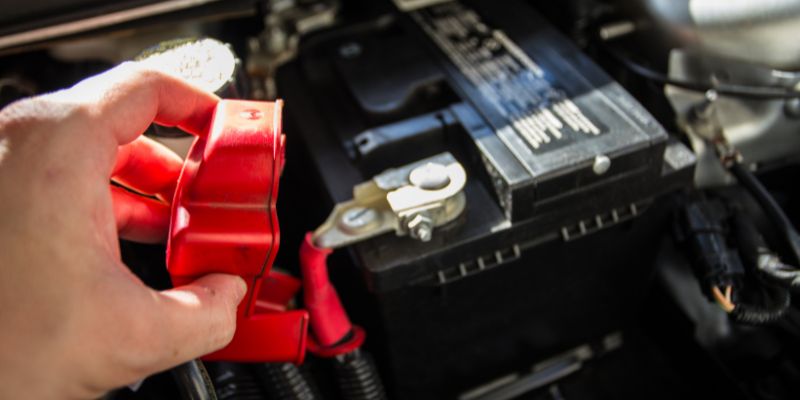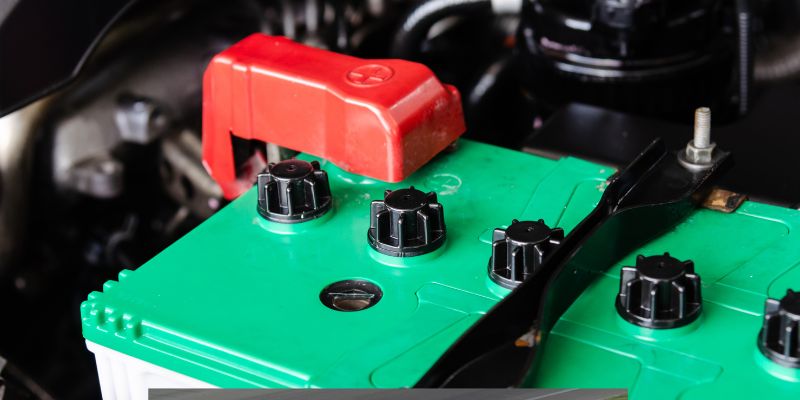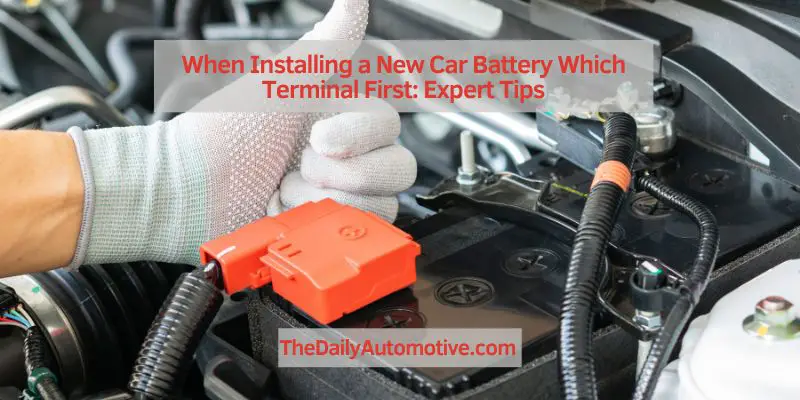When Installing a New Car Battery Which Terminal First: Expert Tips
When installing a new car battery, always connect the positive terminal first, followed by the negative terminal. This ensures proper and safe installation of the battery.
When it comes to maintaining your car, installing a new battery is a common task. Whether your old battery has given out or you simply want to replace it as part of routine maintenance, knowing the proper procedure for installation is essential.
By understanding the correct order for connecting the terminals, you can confidently replace your car battery and ensure the continued smooth operation of your vehicle. We will discuss the steps for installing a new car battery and provide useful tips for a successful and safe installation process.
Preparing To Install A New Car Battery
When it comes to installing a new car battery, it’s essential to follow the correct steps to ensure safety and efficiency. Before starting the installation process, it’s crucial to gather the necessary tools and take safety precautions to prevent any accidents. In this section, we’ll discuss the steps for preparing to install a new car battery.
Check The Required Tools
Before starting the installation process, ensure that you have the following tools on hand:
- Battery Terminal Cleaner
- Safety Gloves
- Wrench/Spanner
Ensuring Safety Measures
When working with car batteries, safety should be a top priority. Ensure that you have the necessary safety equipment, such as safety gloves, to protect your hands from any potential acid exposure.

Disconnecting The Old Battery
Before installing a new car battery, it’s important to disconnect the old battery. Use a wrench or spanner to loosen the nuts on the battery terminals.
Safety Precautions For Handling The Battery
Handling a car battery requires caution. Ensure that the battery is placed on a stable surface to prevent tipping, and avoid exposing it to excessive heat or open flames.
Identifying The Correct Terminal For First Connection
When installing a new car battery, one crucial step is identifying the correct terminal for the first connection. By understanding terminal polarity, the labels for positive and negative terminals, and the importance of correct terminal connection, you can ensure a smooth and safe battery installation process.
Understanding Terminal Polarity
Car batteries have two terminals, one positive (+) and one negative (-), which are essential for the proper functioning of the vehicle’s electrical system. Understanding the concept of terminal polarity is fundamental to correctly connecting the new battery.
Positive And Negative Terminal Labels
The positive terminal is typically marked with a plus sign (+), while the negative terminal is marked with a minus sign (-). It is crucial to correctly identify these labels to avoid improper connections that could lead to potential electrical hazards.
Importance Of Correct Terminal Connection
- Improper terminal connection can result in electrical system malfunctioning.
- Correct connection prevents potential damage to the vehicle’s sensitive electronic components.
- It ensures the safe and efficient operation of the battery and the vehicle’s electrical system.
Determining The First Terminal To Connect
Before connecting the terminals, it is important to determine which terminal to connect first. The proper sequence of terminal connection can significantly impact the safety and efficiency of the battery installation process.
Expert Tips For Identifying The Correct Terminal
- Refer to the vehicle’s owner’s manual for specific instructions on battery installation.
- Inspect the old battery to identify the correct terminal connections.
- Check for terminal labels or color-coded indicators to differentiate between the positive and negative terminals.
Avoiding Common Misconceptions
It is important to be aware of common misconceptions when identifying the correct terminal for first connection. Avoid relying solely on terminal color or assuming the position of the terminals based on their physical location in the vehicle.
Step-by-step Guide For Installing A New Car Battery
When installing a new car battery, it’s important to prioritize safety by connecting the positive terminal first, followed by the negative terminal. Taking this step-by-step approach can help prevent accidents and ensure a smooth installation process.
Positioning The New Battery
Properly positioning the new battery in your car is crucial to ensure a seamless installation process and optimal performance.
Proper Placement In The Battery Tray
Secure the new battery firmly in the designated battery tray to prevent any movement or potential damage.
Ensuring Stability
Stability is key to a safe installation, so double-check that the new battery is stable in its position before proceeding.
Connecting The First Terminal
When it comes to connecting the first terminal, follow the steps below to ensure a successful connection.
Proper Technique For Connecting The Terminal
Adhering to the correct technique when connecting the terminal is essential to avoid any electrical mishaps.
Ensuring A Secure Connection
Verify that the first terminal is securely connected to the new battery to prevent any loose connections.
Next Steps After Connecting The First Terminal
Once the first terminal is securely connected, it’s time to proceed to the next steps in the installation process.
Safety Checks And Visual Inspection
Prioritize safety by conducting thorough checks and visually inspecting the newly installed car battery.
Connecting The Second Terminal
Complete the installation process by connecting the second terminal using the following guidelines.
Testing The New Battery Installation
After successfully installing a new car battery, it is crucial to perform several tests to ensure it is functioning as expected. Testing the new battery installation includes performing a voltage check, testing battery functionality, starting the car, and verifying the electrical components.
Performing A Voltage Check
Before starting the engine, it is essential to perform a voltage check on the new battery. This can be done using a multimeter to measure the voltage across the terminals. Ensure the multimeter is set to the DC voltage mode for accurate readings.
Importance Of Checking Voltage
The voltage check is crucial as it confirms whether the battery is holding a charge and is capable of providing the required power to start the vehicle. Checking the voltage also helps identify any potential issues with the new battery installation.
Safe Voltage Range
The recommended safe voltage range for a fully charged car battery is between 12.6 and 12.8 volts. Any reading below this range may indicate a low charge, while a reading above could hint at overcharging. It is important to ensure that the voltage falls within this safe range for optimal battery performance.
Testing Battery Functionality
After confirming the voltage, the next step is to test the battery’s functionality. This involves connecting the terminals and ensuring that the connections are secure. Testing the battery functionality helps to ensure that the new installation is working as intended.
Starting The Car
Once the voltage and functionality checks have been completed, start the car to observe the response. If the engine starts smoothly and without any hesitation, it indicates that the new battery installation is successful.
Verifying Electrical Components
Finally, it is important to verify the functionality of the electrical components in the vehicle, such as the lights, radio, and air conditioning. Verifying these components ensures that the new battery is providing power to all necessary systems in the vehicle.
Maintaining The New Car Battery
After installing a new car battery, it is essential to continue maintaining it in order to ensure optimal performance and longevity. Regular maintenance practices, checking for corrosion, cleaning the terminals, longevity tips, avoiding overcharging, and extreme weather considerations are crucial aspects to keep in mind.
Regular Maintenance Practices
Regularly inspecting the car battery and its components is crucial. This involves checking for any signs of wear, leaks, or corrosion. Additionally, ensure that the connections are secure and tight to prevent any potential issues.
Checking For Corrosion
Periodically check the battery terminals for any signs of corrosion. Corrosion can hinder the flow of electricity and lead to potential starting issues. If corrosion is present, it needs to be addressed promptly to prevent further damage to the terminals and the battery itself.

Cleaning The Terminals
It is important to regularly clean the battery terminals to remove any buildup of corrosion or dirt. Utilize a mixture of baking soda and water to gently scrub the terminals, ensuring they are free from any contaminants that may interfere with the battery’s performance.
Longevity Tips
Several practices can help extend the life of a car battery. These include avoiding frequent short trips, ensuring all electrical components are turned off when the vehicle is not in use, and keeping the battery secure to prevent excessive vibrations that may cause damage.
Avoiding Overcharging
Overcharging the battery can significantly reduce its lifespan. It is important to use a charger with the appropriate settings and to adhere to the manufacturer’s guidelines to prevent overcharging, which can lead to damage and a shorter battery life.
Extreme Weather Considerations
Extreme temperatures can impact the performance of a car battery. During hot weather, ensure the battery is adequately ventilated and not exposed to direct sunlight, while in cold weather, consider using a battery heater or insulator to maintain its efficiency.
Frequently Asked Questions On When Installing A New Car Battery Which Terminal First
Why Is It Important To Know Which Terminal To Connect First When Installing A New Car Battery?
It’s crucial to connect the positive terminal first to prevent electrical sparks and potential damage to the car’s electrical system. This sequence minimizes the risk of accidents and ensures a smooth installation process.
What Are The Potential Risks Of Connecting The Negative Terminal First When Replacing A Car Battery?
Connecting the negative terminal first can lead to electrical sparks and potential damage to the car’s electrical system. This can also result in safety hazards and damage to the battery or other components of the vehicle.
Are There Specific Tools Required For Installing A New Car Battery?
Yes, basic tools such as a wrench or socket set may be required to loosen the battery terminals and secure the new battery in place. It’s important to use the right tools to ensure a secure and proper installation.
Can I Replace My Car Battery Without Professional Help?
Yes, replacing a car battery is a relatively straightforward task. With the right knowledge and safety precautions, most car owners can confidently replace their own battery. However, if in doubt, it’s always best to seek professional assistance.
Conclusion
To sum up, installing a new car battery may seem daunting, but by following the proper steps, it can be a simple task. Remember to always connect the positive terminal first, followed by the negative terminal. This sequence will minimize the risk of short-circuiting and ensure a safe and successful installation process.






